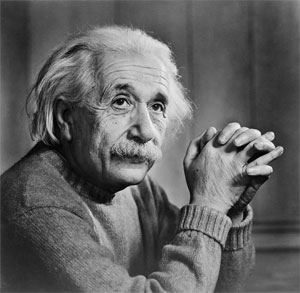The image that I am going to chose from the Karsh exhibition at the Winnipeg Art Museum is his photo of Albert Einstein from 1948. I was trying to choose between this photo and his photo of Muhammad Ali which was shot in 1970. I had a hard time choosing between all the wonderful images, but decided came down to his photo of Ali and his photo of Einstein, I ended up choosing Einstein, because the darkroom techniques are more apparent (to me). I can't believe how great the lighting is in this photo and almost everyone of his photos. Obviously he is doing some darkroom manipulation, but he obviously still had fantastic lighting to begin.
The technical aspects of this image are all spot on. There are really no compositional or technical suggestions that I could give that would make this photo any stronger. It is probably as close to a "Perfect Image" as any photo you will ever see. The compositional elements of this subject are amazing, the eyes have perfect placement and focus, the positioning of the hands and of course the lighting. The image's contrast looks incredible, obviously some selective contrast/burning/dodging has been applied to give it that perfect contrast, on top of excellent lighting to begin with of course. If I were to comment on specific darkroom techniques he did on this image I would firstly look at the eyes, they are clearly darker/more contrast than the rest of the image, which brings me to believe he burned the eyes in for a long time in the darkroom, he may have also added split contrast in the eyes. The other areas that stand out to me are the hands, they are very contrasty and most likely have burning in the shadowed areas. There is an area around his left arm that appears less contrasty and a little brighter than the rest of the image, I would imagine he either did less processing/burning around this area or perhaps dodged it. The background to me looks like the most obvious area that was burned (other than the eye pupils) it is clearly much darker and helps bring attention to the brighter face. I would imagine Yousuf Karsh attempted many different things in the darkroom to give him that "look" he has in most of his images.
I would be curious to see what the original negative looked printed without any processing, just for my own curiosity.
Here is the image I am referencing

Large (600PX):
http://ffden-2.phys.uaf.edu/211_fall2004.web.dir/George_Walker/Albert_Einstein_by_Yousuf_Karsh.jpg